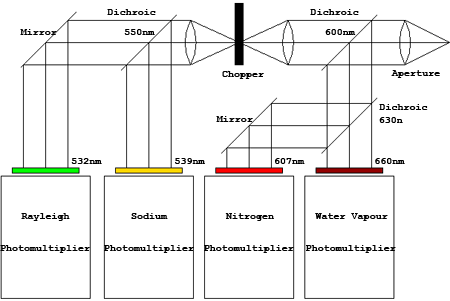
|
|
Raman ScatteringRaman scattering is an inelastic scattering process. This means that there is an exchange of energy between the scattered photon and the scattering molecule. Raman scattering leaves the molecule in a different vibrational and/or rotation state. Due to the unique rotation and vibrational energy levels for each type of molecule Raman scattered light is shifted a different amount by different types of molecules. This allows the type of scattering molecule to be identified from the wavelength shift of the scattered light. This allows us to measure the photons from specific molecules in the atmosphere. The shifts we use are 3652 cm-1 for water vapour and 2331 cm-1 for molecular nitrogen. TransmitterThe Purple Crow Raman-scatter Lidar employs a seeded Nd:YAG laser which produces a 20 Hz, 600 mJ per pulse 532 nm beam. In fact it is the same beam that is produced for the Rayleigh-scatter system. The laser system is housed in its own temperature controlled room to help maintain the frequency stability of the system. The laser beam is expanded to a diameter of 27 mm in order to reduce the divergence to 0.2 mrad full width. ReceiverThe collector for the receiver is a liquid mercury telescope. Backscattered photons are focused onto the entrance aperture of the detector box which is located at the primary focus. Here is a diagram of the detector system.  Light at wavelenght longer than 590 nm is refleted from a dichroic mirror and then further split by dy a 630 nm dichroic beam splitter into the water vapour (at 660 nm) beam and the nitrogen (at 607 nm) beam. These two beams are each passed through an interference filters inorder to remove background light and then onto photomultipliers. The photomultipliers convert the light into electrical signals. These electric signals are recorded by multi-channel-scallers which counts the signals and form a altitude profile of the numer of photons scattered from both water vopor and nitrogen molecules. |
